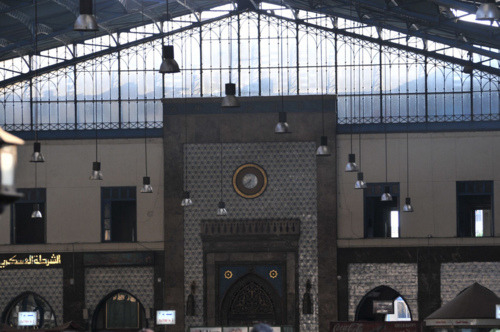The Cairo Landmarks Preservation Commission


Imagine if there was such a thing! and there should be, after all Cairo has some of the world’s most important, beautiful and significant historic monuments. Many of Cairo’s historic buildings are not museum pieces, they are living, lived and inhabited elements of a complex urban fabric. Historic preservation and landmark status (if we follow already existing and very successful models) help these buildings continue to be inhabited and part of the community, but landmark status and preservation can raise the economic, historic, cultural and touristic potential of Cairo’s endlessly interesting urban fabric.
The two images above are of the Cairo Station hall before and after the ongoing “renovation.” The architectural characteristic of this historic building is being vandalized with no respect to scale, historic character, function, or aesthetics. a Cairo Landmarks Preservation Commission, if one existed, would have prevented such a catastrophe from taking place and would have supervised a legitimate renovation effort.
As I wrote in a recent article, this station is the place of memories and history. It was the stage of Egyptian politics and culture. Here is a scene from a 1960s film (Romance in Karnak- غرام في الكرنك) where the station is the backdrop to a dance number by the famous Reda troupe.


so what would a Cairo Landmarks Preservation Commission do? Something very similar to what New York City’s commission does, here is that organization’s mission:
Mission of the Landmarks Preservation Commission
The Landmarks Preservation Commission is the New York City agency responsible for identifying and designating the city’s landmarks and the buildings in the city’s historic districts. The Commission also regulates changes to designated buildings. The agency consists of eleven Commissioners and about fifty full-time staff members, including architects, architectural historians, restoration specialists, planners, and archaeologists, as well as administrative, legal, and clerical personnel. Although it is one of the smallest New York City agencies, the Commission is the largest municipal preservation agency in the United States. The Landmarks Preservation Commission was established by the Landmarks Law in 1965 in order to:
- Safeguard the city’s historic, aesthetic, and cultural heritage.
- Help stabilize and improve property values in historic districts.
- Encourage civic pride in the beauty and accomplishments of the past.
- Protect and enhance the city’s attractions for tourists.
- Strengthen the city’s economy.
- Promote the use of landmarks for the education, pleasure, and welfare of the people of New York City
check NYC’s LPC website and imagine Cairo if such an organization is created with the mandate to preserve, protect and promote Cairo’s architectural gems.
The 1965 Landmarks law followed the destruction of New York City’s Pennsylvania Station seen here. This building no longer exists but its destruction lead to the law that now protects New York City’s architectural heritage. Lets push for the creation of such a long overdue law here in Cairo before our station is destroyed.
NOTE (added May 13, 2011): In December 1881 the Khedive Tawfiq established a committee responsible for the preservation of Islamic and Coptic monuments in Egypt. As a body within the Ministry of Awqaf (charitable endowments) it was an Egyptian institution, although also known by its French title, Comité de Conservation des Monuments de l’Art Arabe.
This is important because we can say that we already had in the Cairo context an institution that preserved historic buildings, and this was established over a century ago. The Comité had its politics and interests and much has been written about it. although the Comité was formally dissolved in 1961, its activity was severely reduced in the last forty years of its life. This is important because looking forward to creating a new commission in Cairo should build on the history of the Comité as an institution as well as learn from other experiences such as that of New York for example after 1965.
UPDATE (May 15, 2011): Seems like the conversation regarding the station generated some kind of official response (the Railway Company essentially says that they own the property and they have the right to do what they wish with it). http://www.akhbarak.net/article/2496229


3 notes
joygarnett liked this
 litbox-blog liked this
litbox-blog liked this cairobserver posted this

